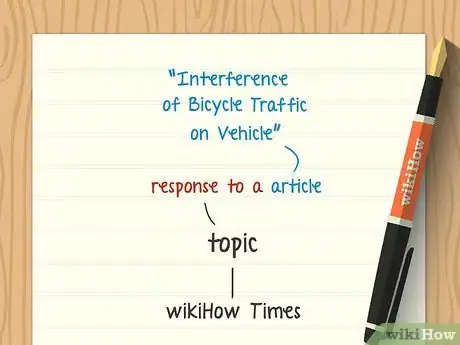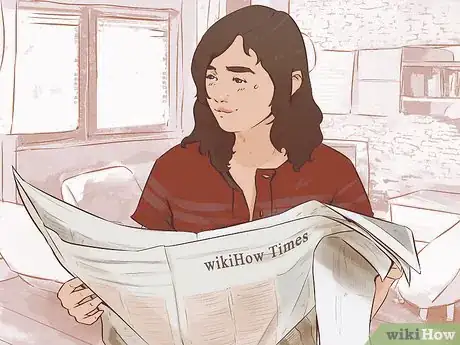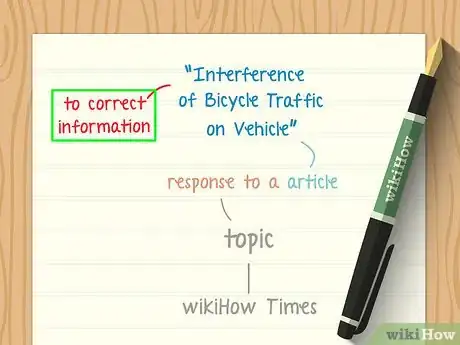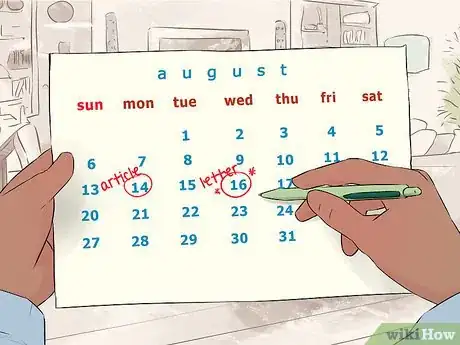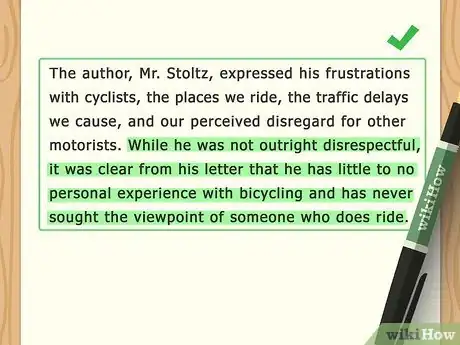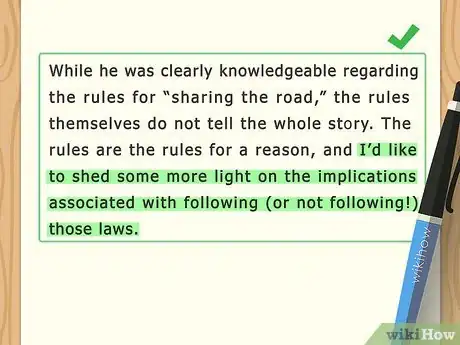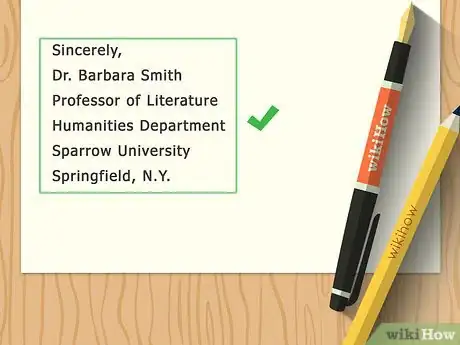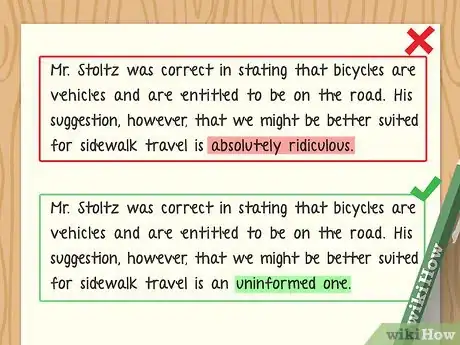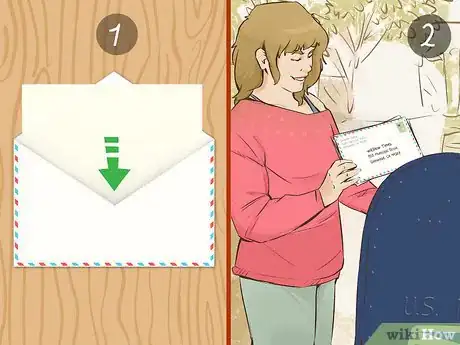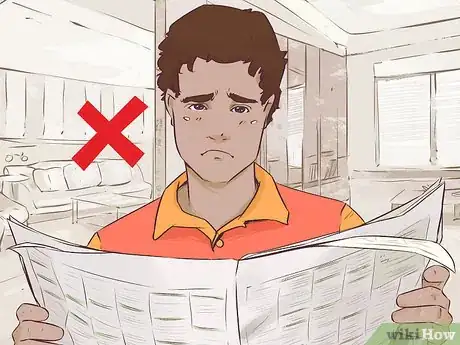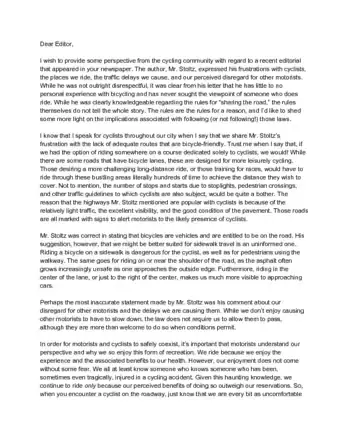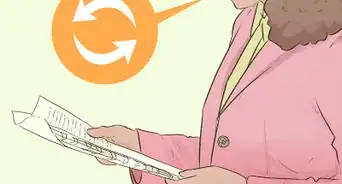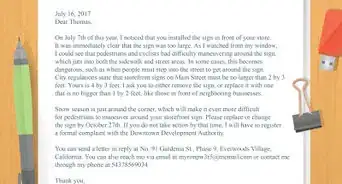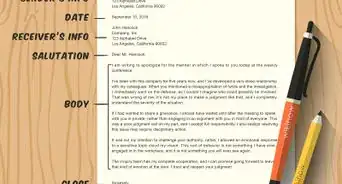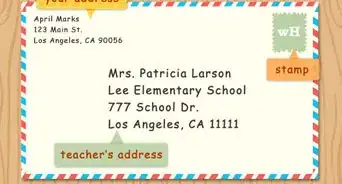This article was co-authored by Mary Erickson, PhD. Mary Erickson is a Visiting Assistant Professor at Western Washington University. Mary received her PhD in Communication and Society from the University of Oregon in 2011. She is a member of the Modern Language Association, the National Communication Association, and the Society for Cinema and Media Studies.
There are 10 references cited in this article, which can be found at the bottom of the page.
This article has been viewed 1,503,579 times.
Writing letters to the editor is a great way to engage with a topic you're passionate about and to influence public opinion. Although having your letter selected is never easy, you can greatly improve your chances of catching an editor's eye by following a few basic guidelines. If you want to know how to write a letter to the editor, just follow these steps.
Steps
Preparing to Write Your Letter
-
1Decide on the topic and paper. Your letter to the editor can be a response to a number of things. Most likely, it will be a response to a specific article, but your letter could also be a response to an event or issue in your community.
- It's best to respond to a particular article that was published by the newspaper. Then, your letter will be more likely to be chosen for publication, and always be ready for rejection.
- If you are responding to a community event or issue, your local newspaper is likely to be the most appropriate venue for your letter to the editor.
-
2Read other letters to the editor from the paper you've chosen. Before you start writing your own letter, you should read through other letters to the editor of the paper you've chosen to get inspiration. Each paper's letters will differ slightly in form, style, tone, and even in length. Read these letters to get a better idea of how to phrase your letters and to see what appeals to the editors of that paper.[1]Advertisement
-
3Check out the guidelines of the paper you've chosen. Most papers will have guidelines for the types of letters they will publish.[2] Most papers have rules regarding the letter's length. They also typically ask that you include your name and contact information for verification. There may be additional guidelines. A number of papers won't allow political endorsement and limit how often individuals can submit. Make sure to read these guidelines before you send off your work.
- If you can't find the guidelines for submitting letters, call the publication to ask.
-
4Determine your reason for writing the letter. There are a number of approaches to writing these types of letters. Your approach is dependent upon why you are writing the letter. Determine what you hope to accomplish by writing the letter. Some reasons might include:[3]
- You are angry about an issue and you want the readers to know about it.
- You want to publicly congratulate or support something or someone in your community.
- You want to correct information in an article.
- You want to suggest an idea to others.
- You want to influence public opinion or persuade others to take action.
- You want to influence policymakers or elected officials.
- You want to publicize a certain organization's work in connection with a current news issue.
-
5Write your letter within two to three days of the article. Make sure your letter is timely by sending in your letter shortly after the article in question was published. This will improve your chances of getting published, since the issue will still be fresh in the editor's mind (and the readers' minds).[4]
- If you're responding to an article in a weekly newspaper, send in your letter in time for it to be published in the next issue. See the newspaper's guidelines for the publication deadline.
Beginning Your Letter to the Editor
-
1Include your return address and contact information. Make sure to include your full contact information at the top of your letter. This will include not only your address, but also your email address, and daytime phone number.
- If your letter is chosen, the editors will use this information to get in touch with you.
- If the newspaper has an online submission system, it will likely have a space for you to include this information.
-
2Include the date. After your contact information, leave a blank line and then add the date. Write it formally, as you would in a business letter, such as: “Feb 25, 2016.”
-
3Include the recipient's name and address. If you are writing an email or sending in a physical letter, address the letter as you would a business letter.[5] Include the recipient's name, position, company, and address. If you don't know the editor's name, you can either find it in the newspaper, or you can just write “Editor.”
-
4State if you want your letter published anonymously. It's usually a good idea to attach your name to your letter, and some newspapers won't publish letters anonymously anyway. But sometimes, there may be a circumstance where you want to state your opinion but you don't want people to know who you are. Add a note to the editor that your letter needs to be published anonymously.
- Unless you've written about a provocative issue, it's unlikely that your letter will be published if you've also requested anonymity.
- You will still need to provide your name and contact information, so that the newspaper can verify your letter. The newspaper won't publish your information if you've asked it not to.
-
5Write a simple salutation. There's no need to be fancy here. Just write "To the editor,” "To the editor of The Herald," or “Dear Editor.” Follow this salutation with a comma or a colon.
Crafting Your Letter to the Editor
-
1State the article you're responding to. Orient your readers as quickly as possibly by stating the name and date of the article that you're responding to. Also, include the article's argument. You can do this in just one or two sentences.[6]
- For example: "As a literature professor, I must take issue with your editorial ("Why Novels no Longer Matter in the Classroom," March 18th)."
-
2State your position. After you've stated the argument you're responding to, you should clearly state the position you're taking on the issue and why you feel a certain way. If your authority relates to the issue in some way, then state your occupation as well. Take this time to show why the issue is relevant and important, but remember to be brief.
- For example: "While the article states that college students no longer take pleasure in reading, everything I've seen in my classroom is evidence to the contrary. The article is not only inaccurate, but provides a very cursory explanation of the many reasons why students may be challenged by reading fiction in a college setting. Students aren't getting "bored" with fiction because the novel is no longer relevant; rather, their enthusiasm is waning because of professors who are losing interest in their own subject matter."
-
3Focus on one major point. Your letter is too short to cover much ground. Give your letter more force by focusing on one issue and providing evidence for that issue.[7]
-
4Make your most important point up front. This helps your reader identify exactly what you're arguing from the get-go. If your letter is edited, it will be cut from the bottom up. If your most important point is at the beginning, it won't get lost in the editing.
-
5Provide evidence. Now that you've stated your position on an issue, you need to back it up with some facts. If you want your letter to be chosen, then you need to show that you've put some thought and research into formulating your letter. Though you don't have a lot of space, just providing a few key facts can make a big difference. Here are some great ways to provide evidence:[8]
- Use recent events in your state or community as evidence.
- Use statistics, data, or survey results.
- Tell a personal story that tells a larger point.
- Use current events in politics for support.
-
6Use a personal example. To make your point relevant, use a personal story. Readers can more easily recognize the impact that news can have on a person when that person shares a personal story.[9]
-
7Say what should be done. Once you've provided evidence for your point of view, end the letter by saying what can be done to address the issue. Perhaps just raising awareness of the issue in the community is enough, but there may be other things that people can do to address the issue and get involved.
- Point the readers to actions they can take to be more involved in the issue in their local communities.
- Direct the readers to a website or organization that can further their goals.
- Give the readers a way to find more information on the subject.
- Instruct the readers directly. Tell them to do something, whether it's to call their local congressperson, vote, recycle, or volunteer in their communities.
-
8Name names in your letter. If your letter is intended to influence a legislator or a corporation to take a specific action, name that person or corporation. The staff working for the legislator is collecting news mentions of the legislator. Corporations are doing the same. These people will be more likely to read your letter if you name them specifically.[10]
-
9Have a simple closing. Have one sentence that summarizes your point of view on the issue so your readers have a clear reminder of your main message.
-
10Include a closing phrase along with your name and city. At the very end of your letter, include a simple “Sincerely,” or “Best regards,” to finish your letter. Then include your name and city. Include your state if the newspaper is not your local publication.
-
11Include your affiliation if you are writing in your professional capacity. If your professional expertise is relevant to your article, then include this information between your name and residence. If you are attaching your company's name to your letter, you are implicitly stating that you are speaking on behalf of the organization. If you are writing on your own, then omit your company name. You can still use your professional title if it is relevant to the issue addressed in your letter. The following is an example that uses an organizational affiliation:
- Dr. Barbara Smith
- Professor of Literature
- Humanities Department
- Sparrow University
- Springfield, N.Y.
Editing Your Letter to the Editor
-
1Be original. If you say exactly what everyone else is saying, then your letter won't get chosen. Find a way to put a new spin on an old issue. Your letter may also have a higher chance of getting printed if you have summarized many other letters in an eloquent and provocative way.
-
2Trim down your letter to avoid wordiness. Most letters to the editor are between 150 and 300 words long. Remember to be as concise as possible.
- Cut out extraneous phrases or flowery language. Be straight and to the point. This will help you cut down on your word count.
- Eliminate phrases like “I think.” It's apparent that the content of your letter is what you think, so you don't need to waste the words.[11]
-
3Be respectful and professional in tone. Even if you disagree with an issue, maintain a respectful tone instead of being angry or accusatory. Keep your tone formal and avoid slang or overly casual phrasing.
- Don't insult your readers, the article's author, or your opponents. Keep an even keel when writing your letter.[12]
-
4Write to the level of the readers. Make sure your letter is written at an appropriate reading level for the newspaper's audience.
- Avoid jargon, acronyms and abbreviations. The readers might not know certain industry jargon or abbreviations that are common in your field. Spell out acronyms and abbreviations. Use more common language in place of jargon.[13]
-
5Proofread your work. Once you're happy with the wording of your letter, proofread your paper to check for grammar and spelling mistakes. Remember that you're competing against many other letter writers, sometimes numbering in the thousands for a national paper. If you have a stray comma or a grammatical hiccup, you risk looking less professional than your competition.
- Read your letter aloud to make sure that the flow of punctuation is natural.
- Ask someone to read your letter. Another set of eyes on your letter will help improve clarity. He may also catch errors that you missed.
Finalizing Your Letter
-
1Send in your letter. Once you've finished your letter, send it to the paper you've chosen. The paper's guidelines should say which form of submission is best. Most papers ask for an electronic submission, either via email or through an online submission system. Some traditional newspapers may still prefer a physical copy of your letter.
-
2Know that your letter may be edited. The newspaper reserves the right to edit a letter. The paper will primarily edit for length, or to slightly alter an unclear passage. [14] The paper won't change the overall tone or argument of your letter.
- If your letter contains libelous or inflammatory language, this may be edited out. Or, your letter may not be published at all.
-
3Follow up with your letter. If your letter is printed and you have requested particular action on the part of a legislator or corporation, follow up with that individual or company. Clip out your letter and send it to the legislator or corporation. Include a note that addresses the action you've requested.[15]
-
4Don't be disappointed if your letter doesn't get chosen. No matter how perfect your letter might have been, there is always a chance that other letters will catch the editor's eye and that yours will not be published. That's okay. Now that you know how to write a letter to the editor, you'll be a pro at writing future letters. Be proud of yourself for stating your opinion and advocating for something you believe in.
-
5Try sending your letter elsewhere. If your letter was not published but you still feel strongly about the topic letter, try sending a similar letter addressing a similar topic in a different paper.
Sample Letter
Community Q&A
-
QuestionI want to publish my school advertisement. How do I write a request to the editor of a newspaper?
 Community AnswerMost local papers have the editor's contact information in the newspaper. If information isn't listed, go online and search the editor's name and/or the name of the paper. In terms of spreading awareness, if you are passionate about the issue at hand, it will be easy to move somebody on the matter. If you can get the editor concerned about it, he/she will help spread the word.
Community AnswerMost local papers have the editor's contact information in the newspaper. If information isn't listed, go online and search the editor's name and/or the name of the paper. In terms of spreading awareness, if you are passionate about the issue at hand, it will be easy to move somebody on the matter. If you can get the editor concerned about it, he/she will help spread the word. -
QuestionHow can I write a letter to a paper editor to get him/her to spread awareness?
 Community AnswerMost local papers have the editor's contact information in the newspaper. If information isn't listed, go online and search the editor's name and/or the name of the paper. In terms spreading awareness, if you are passionate about the issue at hand, it will be easy to move somebody on the matter. If you can get the editor concerned about it, he/she will spread the word.
Community AnswerMost local papers have the editor's contact information in the newspaper. If information isn't listed, go online and search the editor's name and/or the name of the paper. In terms spreading awareness, if you are passionate about the issue at hand, it will be easy to move somebody on the matter. If you can get the editor concerned about it, he/she will spread the word. -
QuestionWhat is the best way to write a conclusion to an editorial letter?
 Community AnswerAlmost as though you are restating your thesis. In one short sentence, repeat the main point of your entire letter.
Community AnswerAlmost as though you are restating your thesis. In one short sentence, repeat the main point of your entire letter.
References
- ↑ http://reclaimdemocracy.org/effective_letters_editor/
- ↑ http://www.ucsusa.org/action/writing-an-lte.html#.VYnRPUaECug
- ↑ http://ctb.ku.edu/en/table-of-contents/advocacy/direct-action/letters-to-editor/main
- ↑ http://reclaimdemocracy.org/effective_letters_editor/
- ↑ https://owl.english.purdue.edu/owl/resource/653/01/
- ↑ http://ctb.ku.edu/en/tablecontents/sub_section_main_1239.aspx
- ↑ http://reclaimdemocracy.org/effective_letters_editor/
- ↑ http://www.druglibrary.org/schaffer/activist/howlte.htm
- ↑ http://www.ncte.org/action/write
- ↑ http://www.ucsusa.org/action/writing-an-lte.html#.VYnRPUaECug
- ↑ http://reclaimdemocracy.org/effective_letters_editor/
- ↑ http://reclaimdemocracy.org/effective_letters_editor/
- ↑ http://reclaimdemocracy.org/effective_letters_editor/
- ↑ http://np.news-press.com/contact/letter-to-editor
- ↑ http://www.ucsusa.org/action/writing-an-lte.html#.VYnRPUaECug
- ↑ http://ctb.ku.edu/en/table-of-contents/advocacy/direct-action/letters-to-editor/main
About This Article
To write letters to the editor, format the letter with the date, your name and address, and the recipient's name and address. Start with a simple salutation, then identify the article you're responding to. Next, state your position on the matter, focusing on one major point you want to make. Provide evidence or personal experiences to support your position and include a probable solution. Don't forget to proofread your letter carefully before sending it in! For tips on tone and etiquette, read on!
